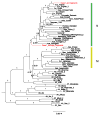An early modern human from Romania with a recent Neanderthal ancestor
- PMID: 26098372
- PMCID: PMC4537386
- DOI: 10.1038/nature14558
An early modern human from Romania with a recent Neanderthal ancestor
Abstract
Neanderthals are thought to have disappeared in Europe approximately 39,000-41,000 years ago but they have contributed 1-3% of the DNA of present-day people in Eurasia. Here we analyse DNA from a 37,000-42,000-year-old modern human from Peştera cu Oase, Romania. Although the specimen contains small amounts of human DNA, we use an enrichment strategy to isolate sites that are informative about its relationship to Neanderthals and present-day humans. We find that on the order of 6-9% of the genome of the Oase individual is derived from Neanderthals, more than any other modern human sequenced to date. Three chromosomal segments of Neanderthal ancestry are over 50 centimorgans in size, indicating that this individual had a Neanderthal ancestor as recently as four to six generations back. However, the Oase individual does not share more alleles with later Europeans than with East Asians, suggesting that the Oase population did not contribute substantially to later humans in Europe.
Conflict of interest statement
The authors declare no competing financial interests.
Figures



References
-
- Higham T, et al. The timing and spatiotemporal patterning of Neanderthal disappearance. Nature. 2014;512:306–309. - PubMed
-
- Smith FH, et al. The Assimilation Model, Modern Human Origins in Europe, and the Extinction of Neandertals. Quaternary International. 2005;137:7–19.
-
- Zilhao J. Neandertals and Moderns Mixed, and It Matters. Evolutionary Anthropology. 2006;15:183–195.
-
- Hublin J-J. The modern human colonization of western Eurasia: when and where? Quaternary Science Reviews. 2014
Publication types
MeSH terms
Grants and funding
LinkOut - more resources
Full Text Sources
Other Literature Sources

